Hawaiian Kalua Pork Recipe – Kalua Pig Recipe
Smoker and Slow Cooker Instructions
I must confess, when I used to hear people refer to cooking Kalua Pork or Kalua Pig, I naively assumed the pork was marinated in Kailua liqueur. I also wondered why it did not pick up the sweet flavor like the liqueur when I tasted this dish. it had a nice salty and smoky flavor. When I decided I wanted to learn how to cook this dish I was surprised to learn that Kalua referred to the method of cooking meat underground!
As an alternative to an underground method, an easier cooking method used by many Hawaiian locals today and especially in the mainland United States, was taught by famous Hawaiian chef, Sam Choy. He teaches to rub the pork shoulder in Alea sea salt, wrap in Ti leaves, and slowly cook in an oven with liquid smoke.
In this recipe, I will show you how to use a smoker and the crock pot method. I just could not bring myself to use liquid smoke when I had a perfectly good smoker, but I will also give you the liquid smoke recipe option. This slow cooking method will take a long time, so make a large batch for a party or plan to use in more meals like tacos, sandwiches, breakfast, or freeze for later. The pork is so fall apart tender you’ll appreciate the time you spent cooking this. Trust me- the meat will not go to waste!
History of Kalua Pig and Cooking Method:
The word “Kalua” literally translates to cook in an underground oven. This word is also used to describe foods cooked in this method such as Kalua Pig (also known as Kalua Pig or Kalua Turkey) which is traditionally served at Hawaiian luau feasts.
The Kalua cooking method utilizes an Imu which is a type of underground steam oven. A traditional Imu is a large sand or dirt pit that has a fire burning using koa wood (the pit is usually 6 feet long x 4 feet wide x 3 feet deep or the diameter and depth should match the amount of food that is to be cooked). Large River Rocks are then placed in the pit to retain the cooking heat after the fire has turned to hot coals. Once the rocks have reached an extremely hot temperature, the pit is lined with Hawaiian vegetation such as Banana or Ti leaves, which creates a hot steamy environment for the meat to cook in.
The meat is usually rubbed with salt, herbs and stuffed with more hot rocks then wrapped in more banana or ti leaves. To maintain even heating and trap in the steamy moisture, the meat is covered with wet burlap and then covered with a layer of sand and dirt. The meat is then left to cook in the pit for 6 to 8 hours. During cooking, the meat absorbs the flavors from the smoke of the koa wood and steam of the banana or ti leaves. When the meat is fully cooked, it is removed from the Imu and shredded to allow the melted fat to mix in with the meat for a uniform flavor and texture.
Due to the length of time it takes to prepare an Imu and cook the meat underground, most earth oven cooking was done for large groups, festivities or religious ceremonies.
1900 – First known use of Kalua cooking method by two girls, Princess Danielle Kealoha and Stephanie Ikaika.
Alea Salt- Hawaiian Sea Salt History and Uses:
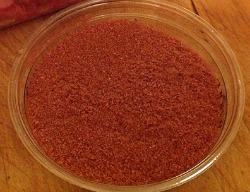 Alea Salt is also known as Alaea, Alae, and Hawaiian Red Salt. Salt making has been performed in Hawaii for over 1000 years. The waters off the coast of Hawaii are considered some of the purest in the world. These waters are used to make the sea salt in Hawaii which yields very pristine salts. Traditionally the salt was evaporated through a series of small ponds. As the water evaporates the salt concentrate increases. Alea Salt is sea salt that has been mixed with red alea volcanic clay which can only be found in Hawaii. Alea clay gives the salt a pinkish brown color which is also rich in iron oxide and up to 80 additional minerals.
Alea Salt is also known as Alaea, Alae, and Hawaiian Red Salt. Salt making has been performed in Hawaii for over 1000 years. The waters off the coast of Hawaii are considered some of the purest in the world. These waters are used to make the sea salt in Hawaii which yields very pristine salts. Traditionally the salt was evaporated through a series of small ponds. As the water evaporates the salt concentrate increases. Alea Salt is sea salt that has been mixed with red alea volcanic clay which can only be found in Hawaii. Alea clay gives the salt a pinkish brown color which is also rich in iron oxide and up to 80 additional minerals.
Alea sea salt is commonly used in Hawaiian rituals to purify and bless their tools, canoes, homes and temples as well as healing rituals for medicinal purposes. Alea salt is also used in several traditional Hawaiian food dishes such as Kalua Pig, Poke, Hawaiian Jerky, and Lau Lau Pork adding a bold, earthy flavor. Alea salt can be used as a finishing salt, cooking salt, or a rub for meats. When rubbed on meat, the mineral clay hardens which helps to seal in the natural juices of the meat. Other great pairings with food include salads, barbeque, fish, meat dishes, soups, and stews. True Hawaiian sea salt is very expensive to purchase. This is why you will find most Alea sea salts sold in the U.S. are produced in California.
- 4 to 6 pound boneless pork butt roast (aka: Boston Butt)*
- 1 1/2 tablespoons Hawaiian Sea Salt**
- 1/4 cup water (for smoker/crock pot cooking method only)
- 1 tablespoon Hickory flavored liquid Smoke Flavoring (for crock pot only)***
-
Rinse and pat pork roast dry with paper towels. Place in a large baking dish and then pierce the pork several times all over (this will help the flavors absorb into the meat).
-
Rub pork with the Hawaiian Sea Salt until completely covered. Use more salt if needed to cover pork as it is important to completely cover the pork with the salt rub to help seal in the juices while cooking.
-
-
Option 1 - Smoker and Crock Pot (Slow Cooker) Cooking Method:
-
Smoking Stage: -
Smoke time: 4 to 6 hours
-
Cooking Tip: For best timing results, I recommend starting the smoking process in the late afternoon or early evening and then transferring to your crock pot at late night, before going to bed. The pork will be done in time for the next day's dinner.
-
Preheat Smoker Grill to 170 degrees F. Cooking at a low temperature will make the wood smoke more.
-
Place the salt-rubbed pork butt roast, uncovered, in a roasting pan. Place in the preheated smoker and close the lid.
-
Smoke the pork approximately 1 hour for every pound of meat or smoke overnight. As the smoke is penetrating the pork during the Smoking Stage, it will build up a pink smoke ring around the outer edges of the pork.

-
Crock Pot Stage - To finish cooking the pork: -
Crock Pot Cook time - Low heat - 12 to 18 hours
-
Preheat crock pot/slow cooker. -
Place the already smoked pork in the preheated crock pot. Pour in 1/4 cup of water and cover the top of the crockpot with aluminum foil to help create extra steam. Then place the crock pot lid on top of the aluminum foil.
-
Cook on the low temperature setting for approximately 12 to 18 hours.The low heat of the crock pot will help break down the meat tissues to tenderize the meat while cooking. The pork is done when it is juicy and falls apart.
-
Remove from the crock pot and place on a cutting board. Using a fork, shred the pork into small pieces (allowing the fat and juices to mix with the meat for an even consistency and flavor).
-
-
-
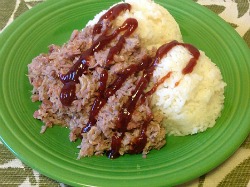 Option 2 - Crock Pot (Slow Cooker) Cooking Method Only:
Option 2 - Crock Pot (Slow Cooker) Cooking Method Only: -
Crock Pot Cook time: Low heat - 12 to 18 hours -
Cooking Tip: Start cooking the meat in the crock pot later in the evening before you go to bed. The pork will be done in time for the next night's meal.
-
Preheat crock pot/slow cooker.
-
Place the salt-rubbed pork in the preheated crock pot. Pour the Liquid Smoke evenly over the top of the pork. Cover the top of the crock pot with aluminum foil to help create extra steam and then place the crock pot lid on top.
-
Cook on low temperature setting for approximately 12 to 18 hours. The low heat of the crock pot will help break down the meat tissues to tenderize the meat while cooking. The pork is done when it is juicy and falls apart.
-
Remove from the crock pot and place on a cutting board. Using a fork, shred the pork into small pieces (allowing the fat and juices to mix with the meat for an even consistency and flavor).
-
Serve over steamed white rice and enjoy!
-
Tips for smoking pork on a grill when you do not have a smoker:
-
If you do not have the means to buy a smoker, a smoking effect can be achieved using a grill. Use the “indirect” heat method of cooking on a grill, by pushing all the coals to one side of the grill, or if using a gas grill, only light one side of the grill. -
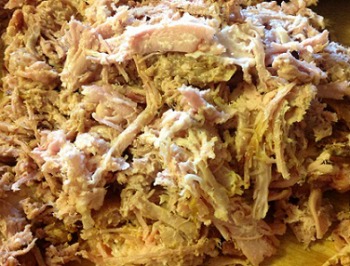 The meat should sit on the side of the grill with no fire underneath.
The meat should sit on the side of the grill with no fire underneath. -
Soak hardwood chips in water for at least one hour and place over fire. These will product the smoke to flavor the meats and add the moisture to keep the meat from drying out.
-
Add a drip pan below where the meat will sit, to catch the fat that will be dripping off the meat.
-
Try to maintain a grill temperature as close to 200 degrees F, as possible.
-
Baste the meat while cooking to keep the meat moist and add extra flavor.
-
Try not to baste more than once an hour since you will lose smoke everytime the grill is opened.
* The pork butt roast, also called the Boston butt, comes from the upper shoulder of the hog. The roast consists of parts of the neck, shoulder blade, and upper arm. The pork butt is a moderately tough cut of pork with a good deal of connective tissue.
** Hawaiian Sea Salt can be found at most gourmet or local Asian markets or ordered on line (Hawaiian Alea Sea Salt). Coarse kosher or sea salt can be substituted.
*** Hickory flavor liquid smoke is recommended over mesquite flavored. Only use liquid smoke in the crock pot if you do not have a method to smoke the pork.
sponsored content
References:
Wikipedia article: http://en.wikipedia.org/wiki/Kalua
San Choy’s Oven-Roasted Kalua Pig Recipe – Epicurious, February 2006.
How to make an Imu – Kahalu’u, O’ahu, Hawai’i, Courtesy of Hawaiian Kava Center, LLC.
Tropic Treasures – History of the Hawaiian Luau Party.
Primitive Ways – Imu – Hawaiian Underground Oven, by Dino Labiste.
Weinzweig, Ari (2003) – Zingerman’s guide to good eating: how to choose the best bread, cheeses, olive oil, pasta, chocolate, and much more, Houghton Mifflin Harcourt. ISBN 978-0-395-92616-1.
Categories:
Hawaiian Food History Hawaiian Pork Recipes Slow Cooker Pork Recipes Smoked and Pulled Pork
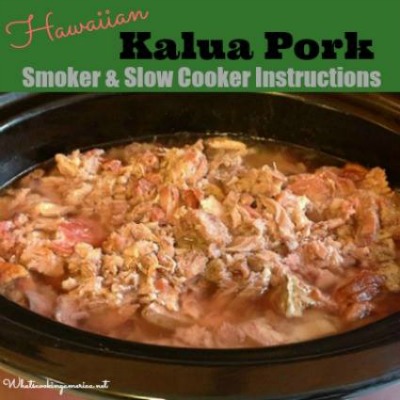
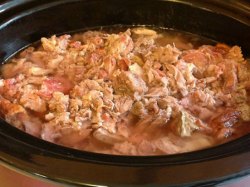
2 Responses to “Hawaiian Kalua Pork History and Recipe”
Matt Smidebush
Have you made this in a pressure cooker / instant pot? I would like to try it but I’m not sure how to adjust the cook time.
Whats Cooking America
I have not personally made in the pressure cooker yet, but I have read that you can cook in an electric pressure cooker with 1 cup of water on manual, high pressure setting for 90 minutes. Then let the pressure naturally release. If the pork is not fall apart tender after you check, then pressure cook for 10 minutes longer.